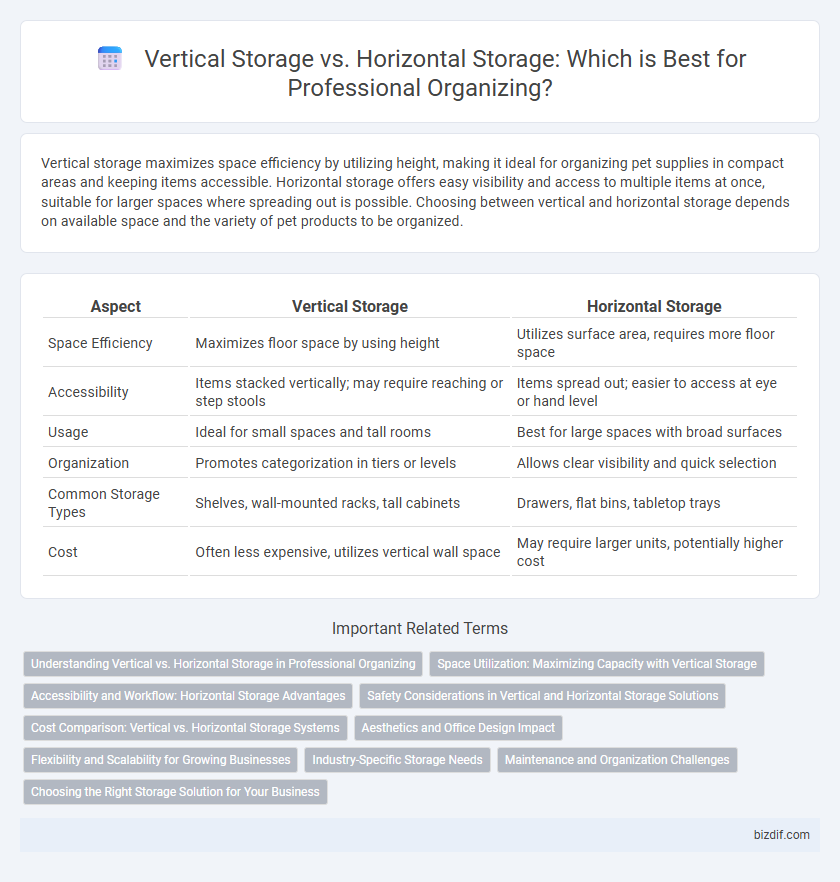Vertical storage maximizes space efficiency by utilizing height, making it ideal for organizing pet supplies in compact areas and keeping items accessible. Horizontal storage offers easy visibility and access to multiple items at once, suitable for larger spaces where spreading out is possible. Choosing between vertical and horizontal storage depends on available space and the variety of pet products to be organized.
Table of Comparison
| Aspect | Vertical Storage | Horizontal Storage |
|---|---|---|
| Space Efficiency | Maximizes floor space by using height | Utilizes surface area, requires more floor space |
| Accessibility | Items stacked vertically; may require reaching or step stools | Items spread out; easier to access at eye or hand level |
| Usage | Ideal for small spaces and tall rooms | Best for large spaces with broad surfaces |
| Organization | Promotes categorization in tiers or levels | Allows clear visibility and quick selection |
| Common Storage Types | Shelves, wall-mounted racks, tall cabinets | Drawers, flat bins, tabletop trays |
| Cost | Often less expensive, utilizes vertical wall space | May require larger units, potentially higher cost |
Understanding Vertical vs. Horizontal Storage in Professional Organizing
Vertical storage maximizes space by utilizing height, making it ideal for small areas and frequently accessed items, while horizontal storage spreads items across a surface, offering easier visibility and access for larger or flat objects. Professional organizers choose vertical storage solutions like tall shelving units, pegboards, and wall-mounted systems to keep floors clear and enhance room efficiency. Horizontal storage works best in drawers, tabletop organizers, and wide shelving, promoting organization of documents, tools, and supplies that require immediate reach and quick identification.
Space Utilization: Maximizing Capacity with Vertical Storage
Vertical storage enhances space utilization by making full use of unused wall and height areas, allowing for increased capacity without expanding the floor footprint. Shelving units, wall-mounted racks, and tall cabinets enable efficient organization and easy access to items, reducing clutter and improving workflow. Compared to horizontal storage, vertical solutions optimize available space in small rooms or offices, supporting a more streamlined and productive environment.
Accessibility and Workflow: Horizontal Storage Advantages
Horizontal storage enhances accessibility by offering clear visibility and easy reach to items laid out side by side, reducing search time and improving efficiency. Its design supports streamlined workflow in professional organizing by allowing simultaneous access to multiple items without stacking or overlapping. This spatial arrangement minimizes disruptions and accelerates task completion in organized spaces.
Safety Considerations in Vertical and Horizontal Storage Solutions
Vertical storage solutions maximize floor space by stacking items upward but require secure anchoring to walls and sturdy shelving to prevent tipping hazards. Horizontal storage offers easier access and reduces the risk of heavy items falling, making it safer for frequently used materials. Proper weight distribution and regular inspections are crucial in both methods to ensure stability and prevent accidents.
Cost Comparison: Vertical vs. Horizontal Storage Systems
Vertical storage systems generally offer a higher cost-efficiency by maximizing space utilization through upward expansion, reducing the need for extensive floor space compared to horizontal storage solutions. Initial setup costs for vertical units tend to be higher due to specialized equipment and installation, but long-term savings arise from better space optimization and reduced real estate expenses. Horizontal storage systems usually involve lower upfront costs but require more floor area, leading to increased overhead in rent and maintenance over time.
Aesthetics and Office Design Impact
Vertical storage maximizes space efficiency by utilizing wall height, creating a sleek and modern office design that enhances visual flow and reduces clutter on surfaces. Horizontal storage offers easy access and surface display options but can contribute to a more crowded aesthetic when overused. Prioritizing vertical storage solutions supports minimalist office aesthetics and promotes a clean, organized environment aligned with contemporary professional organizing principles.
Flexibility and Scalability for Growing Businesses
Vertical storage maximizes floor space by utilizing upward dimensions, offering greater flexibility for growing businesses to expand storage capacity without increasing their footprint. Horizontal storage provides easy access and organization but can limit scalability due to spatial constraints as inventory or materials increase. Combining vertical solutions with modular design ensures scalable, adaptable storage systems that accommodate evolving business needs and fluctuating inventory levels.
Industry-Specific Storage Needs
Vertical storage maximizes space efficiency in industries with limited floor area, such as retail and healthcare, by utilizing height for inventory and equipment. Horizontal storage suits warehouses and manufacturing plants requiring easy access to large quantities of bulky items spread across wide aisles. Industry-specific needs dictate the choice between vertical shelves, mezzanines, or horizontal racks to optimize workflow and inventory management.
Maintenance and Organization Challenges
Vertical storage offers easier accessibility and visibility, reducing maintenance time by allowing items to be organized in a compact, upright manner that minimizes clutter. Horizontal storage often requires more frequent reorganization due to stacking and limited visibility, which can lead to increased difficulty in locating items and maintaining order. Efficient professional organizing balances vertical storage benefits with strategic labeling and categorization to overcome the inherent challenges of horizontal storage systems.
Choosing the Right Storage Solution for Your Business
Vertical storage maximizes floor space by utilizing height, ideal for businesses with limited square footage and frequently accessed items. Horizontal storage offers easier visibility and accessibility, suited for businesses requiring quick, wide-ranging access to inventory or supplies. Selecting the right solution depends on your business layout, item size, and operational workflow to enhance efficiency and space management.
Vertical storage vs Horizontal storage Infographic

 bizdif.com
bizdif.com